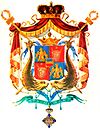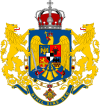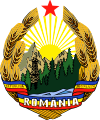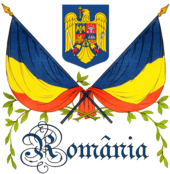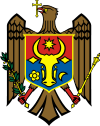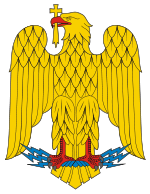- Coat of arms of Romania
-
Coat of arms of Romania 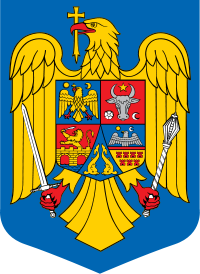
Versions 
The version used for the seals of the Ministers, and on identity cardsDetails Armiger România Adopted April 3, 1870
September 10, 1992Crest None Escutcheon golden aquila; aurochs; dolphins; a black eagle, seven castles, a sun and a moon; lion and a bridge Supporters None Other elements in the aquila's claws: a mace and a sword
in the aquila's beak: an Orthodox crossEarlier versions 1922-1947, the Kingdom of Romania Use on the national currency, in school classes, in the Parliament, on the official buildings, on Passports, on ID cards, in the header of the official documents (including diplomas) The coat of arms of Romania was adopted in the Romanian Parliament on 10 September 1992 as a representative coat of arms for Romania. It is based on the Lesser Coat of Arms of the Kingdom of Romania (used between 1922 and 1947), redesigned by Victor Dima. As a central element it shows a golden aquila holding a cross in its beak and a mace and a sword in its claws. It also consists of the three colors: red, yellow, and blue, which represent the colors of the national flag.
Contents
History
The idea behind the design of the coat of arms of Romania dates since 1859, when the two Romanian countries, Wallachia and Moldavia, united under Alexander John Cuza (common English rendition of Alexandru Ioan Cuza). Then the two heraldic symbols, the golden aquila and the aurochs, were officially juxtaposed.
Until 1866 there were many variants of the coat of arms, regarding the background color and the number of times the two main elements where represented. In 1866, after Carol I was elected Prince of Romania, the shield was divided into quarters: in the first and fourth an eagle was depicted, and in the second and third the aurochs; above the shield the coat of arms of the reigning Hohenzollern-Sigmaringen Family was placed. After the 1872, the coat of arms included the symbol of southern Bessarabia (after 1877, of Dobruja), two dolphins in the fourth quarter, and the one of Oltenia, a golden lion, in the third quarter; on the shield the Steel Crown was placed, as a symbol of sovereignty and independence, after the Romanian War of Independence.
The coat of arms remained unchanged until 1922, after World War I, when Transylvania was united with the Kingdom of Romania. Then the coat of arms of Transylvania was placed in the fourth quarter, with the Turul replaced by a black aquila, the third quarter depicted the joined coats of arms of Banat and Oltenia (the bridge of Apollodorus of Damascus and a golden lion respectively), and the coat of arms of Dobruja was placed in an insertion. The shield was placed on the chest of a golden crossed and crowned aquila, as a symbol of the Latinity of the Romanians. The aquila was placed on a blue shield, capped with the Steel Crown. The coat of arms had three versions: lesser, middle (with supporters and motto), and greater (the middle arms on a mantle red lined with ermine).
After 1948, the Communist authorities changed both the flag and the coat of arms. The coat of arms was rather an emblem, faithful to the Communist pattern: a landscape (depicting a rising sun, a tractor and an oil drill) surrounded by stocks of wheat tied together with a cloth in the colors of the national flag. Until 1989 there were four variants, the first being changed shortly after 1948 (the proclamation of the republic), again changed in 1956 (a red star was added), and finally in 1966, when Romania ceased to be a People's Republic, and became a Socialist Republic.
Immediately after the 1989 Revolution, the idea came up of giving Romania a new, representative coat of arms. In fact, the very symbol of the Revolution was the flag with a hole in its middle where the communist coat of arms had been cut out.
The heraldic commission set up to design a new coat of arms for Romania worked intensely, subjecting to the Parliament two final designs which were then combined. What emerged is the current design adopted by the two chambers of the Romanian Parliament in their joint session on September 10, 1992.
Description
This article is part of
Symbols of Romania seriesFlag of Romania · (history) · (list) Coat of arms of Romania Romanian Anthem Romanian heraldry Orders, decorations and medals Postage stamps of Romania Romanian leu Symbols of Romanian Royalty Symbols of Romania The shield surmounting the eagle is divided in five fields, one for each historical province of Romania with its traditional symbol:
- golden aquila - Wallachia
- aurochs - Moldavia
- dolphins - Dobrogea
- a black aquila, seven castles, a sun and a moon - Transylvania
- lion and a bridge - Oltenia and Banat
Romania’s coat of arms has as a central element the golden aquila holding an Orthodox cross. Traditionally, this eagle appears in the arms of the Argeş county, the town of Piteşti and the town of Curtea de Argeş. It stands for the “nest of the Basarabs”, the nucleus around which Wallachia was organised.
The aquila, being the symbol of Latinity and a heraldic bird of the first order, symbolises courage, determination, the soaring toward great heights, power, grandeur. It is to be found also in Transylvania’s coat of arms.
The shield on which it is placed is azure, symbolising the sky. The eagle holds in its talons the insignia of sovereignty: a mace and a sword, the latter reminding of Moldavia’s ruler, Stephen the Great whereas the mace reminds of Michael the Brave, the first unifier of the Romanian Countries. On the bird’s chest there is a quartered escutcheon with the symbols of the historical Romanian provinces (Wallachia, Moldavia, Transylvania, Banat and Oltenia) as well as two dolphins reminding of the country’s Black Sea Coast.
In the first quarter, Wallachia’s coat of arms, an aquila or holding in its beak a golden Orthodox cross, accompanied by a golden sun on the right and a golden new moon on the left, is displayed against an azure background.
In the second quarter, Moldavia’s traditional coat of arms is shown, gules: an auroch head sable with a mullet of or between its horns, a cinquefoil rose on the dexter and a waning crescent on the sinister, both argent.
The third quarter features the traditional coat of arms of Banat and Oltenia, gules: over waves, a golden bridge with two arched openings (symbolising Roman emperor Trajan’s bridge over the Danube), wherefrom comes a golden lion holding a broadsword in its right forepaw.
The fourth quarter shows the coat of arms of Transylvania with Maramureş and Crişana: a shield parted by a narrow fesse, gules; in the chief, on azure, there is a black aquila with golden beak coming out of the fesse, accompanied by a golden sun on the dexter and a crescent argent on the sinister (symbolizing the Székelys); on the base, on or, there are seven crenellated towers, placed four and three (symbolizing the Saxons).
Also represented are the lands adjacent to the Black Sea (Dobrogea), on azure: two dolphins affronts, head down.
See also
External links
Categories:- Romanian coats of arms
- National coats of arms
- National symbols of Romania
Wikimedia Foundation. 2010.

